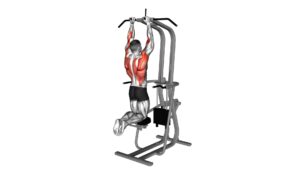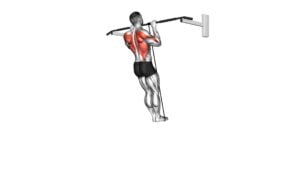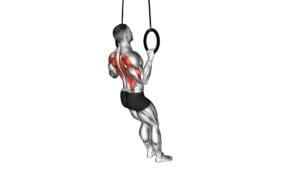Assisted Pull-up – Video Exercise Guide & Tips

Struggling to master the traditional pull-up? You’re not alone. The assisted pull-up is a popular exercise that makes this challenging move more accessible for all fitness levels. Our comprehensive guide will simplify the process, providing video demonstrations, valuable tips and techniques to ensure proper form and progression with your assisted pull-ups.
Watch This Exercise Video
Let’s dive in; transformation awaits!
Key Takeaways
- Assisted pull-ups are a variation of the classic pull-up exercise that use assistance to make it easier for individuals who may not have the strength or ability to perform a full pull-up on their own.
- Machines, resistance bands, and human partners can be used as forms of assistance for assisted pull-ups, each offering its own benefits and allowing for customization based on individual needs and goals.
- To perform assisted pull-ups properly, focus on maintaining proper form and technique, gradually decrease the amount of assistance over time to challenge your muscles, incorporate a variety of grips to target different muscle groups, adjust the weight on an assisted pull-up machine or choose the right band for resistance bands.
What is an Assisted Pull-up?
An assisted pull-up is a variation of the classic pull-up exercise that utilizes assistance to make it easier for individuals who may not have the strength or ability to perform a full pull-up on their own.
Definition
An assisted pull-up is a strength training exercise specifically designed to aid individuals in performing standard pull-ups. This supportive workout routine targets the same primary muscles as traditional pull-ups, including the back, arms, and shoulders but utilizes additional equipment or assistance to help perform the movement.
The three common forms of assistance include machines, resistance bands, and human partners. Each has its pros and cons which can be tailored according to individual needs and fitness goals.
Assisted pull-ups offer an effective way for beginners or those recovering from injuries to build their upper body strength gradually while maintaining proper form throughout each repetition.
Benefits
Assisted pull-ups offer several benefits for individuals who are looking to improve their upper body strength and overall fitness. One of the main advantages is that they provide assistance, allowing beginners or individuals with limited upper body strength to perform the exercise effectively.
By using the assistance from a machine, band, or partner, they can gradually build up their strength and progress towards doing unassisted pull-ups. Assisted pull-ups also target multiple muscles in the upper body including the back, shoulders, arms, and core.
This makes them an effective compound exercise that can help individuals develop a strong and toned physique. Additionally, assisted pull-ups can be customized according to individual fitness levels by adjusting the amount of assistance provided.
Types of assistance (machine, band, partner)
Assisted pull-ups can be performed using different types of assistance, including machines, resistance bands, and a partner. Using an assisted pull-up machine allows you to adjust the weight to suit your strength level and gradually increase it as you get stronger.
Resistance bands provide variable resistance throughout the movement and can be easily attached to a bar for support. Partner-assisted pull-ups involve having someone assist you by holding onto your legs or providing gentle support when needed.
Each type of assistance offers its own benefits and allows you to customize your workout based on your needs and goals.
Tips for Performing Assisted Pull-ups
Focus on maintaining proper form and technique throughout the exercise, keeping your core engaged and avoiding swinging or using momentum. Gradually decrease the amount of assistance you need over time to challenge your muscles and progress towards unassisted pull-ups.
Incorporate a variety of grips, such as wide grip, close grip, or neutral grip, to work different muscle groups and avoid overuse injuries.
Proper form and technique
To perform assisted pull-ups with proper form and technique, start by gripping the bar with your palms facing away from you and your hands slightly wider than shoulder-width apart.
Hang from the bar with straight arms, engaging your core to maintain stability. As you pull yourself up, focus on using your back muscles to initiate the movement, squeezing your shoulder blades together at the top of each rep.
Keep a controlled pace throughout the exercise and avoid swinging or using momentum to propel yourself upward. Lower yourself back down in a controlled manner until your arms are fully extended before starting another rep.
Gradually decreasing assistance
To maximize the benefits of assisted pull-ups and build strength, it is important to gradually decrease the amount of assistance over time. This allows your muscles to adapt and become stronger.
Start by using a band or machine that provides enough assistance for you to perform the exercise with proper form. As you become more comfortable and confident, gradually reduce the assistance by either switching to a lighter resistance band or adjusting the weight on the machine.
By steadily decreasing assistance, you will challenge your muscles and progress towards unassisted pull-ups. Keep pushing yourself and soon enough, you’ll be able to conquer pull-ups without any assistance at all.
Incorporating a variety of grips
To get the most out of your assisted pull-up workout, it’s important to incorporate a variety of grips. By changing your grip, you can target different muscles in your back and arms.
For example, an overhand grip with palms facing away works the latissimus dorsi (lats) and biceps, while an underhand grip with palms facing towards you targets the rhomboids and brachialis.
You can also try a neutral grip with palms facing each other for a combination of both muscle groups. Switching up your grips not only keeps your workouts interesting but also helps to develop balanced strength throughout your upper body.
Using an Assisted Pull-up Machine
Learn how to properly adjust the weight and progress your workouts with an assisted pull-up machine for maximum results.
How to adjust the weight
To adjust the weight on an assisted pull-up machine, start by selecting the appropriate amount of assistance. Most machines have a lever or pin that you can move to different settings.
Begin with a lighter weight and gradually increase it as you become stronger. Aim for a weight that allows you to perform 8-12 reps with proper form and without straining too much.
Adjusting the weight is essential for challenging your muscles and making progress in your pull-up strength.
Weight increments and progressions
To effectively progress in assisted pull-ups, it’s essential to gradually increase the weight you use. This can be done by adding small increments of resistance on the machine or using a heavier band for assistance.
By increasing the load over time, you challenge your muscles and encourage strength gains. It’s important to find the right balance – not too light that it becomes too easy, but not too heavy that it compromises your form.
As you become stronger, continue to adjust the weight incrementally to keep pushing yourself and making progress in your assisted pull-up training.
Using Resistance Bands for Assisted Pull-ups
Learn how to choose the right band and properly attach it for effective assisted pull-ups. Discover the benefits of using resistance bands and why they are a great alternative to machines or partner assistance.
Choosing the right band
To choose the right band for assisted pull-ups, consider your current level of strength and fitness. Look for a band that provides enough resistance to assist you in completing the exercise, but not so much that it becomes too challenging.
A good starting point is a band that allows you to perform 8-12 repetitions with proper form. As you progress and become stronger, gradually move on to bands with less assistance until you can perform pull-ups without any assistance at all.
Remember to always prioritize safety and consult a trainer or professional if needed.
How to attach and use the band
To attach and use the band for assisted pull-ups, start by selecting a resistance band that suits your strength level. Loop one end of the band around the pull-up bar securely. Then, grip the other end of the band with both hands to ensure a tight hold.
As you perform your pull-ups, maintain proper form and technique while allowing the band to provide assistance by taking some of your body weight off. This will help you gradually build strength and improve your ability to perform unassisted pull-ups over time.
Partner Assisted Pull-ups
Learn how to properly assist and spot someone during partner assisted pull-ups, along with communication and safety tips for a successful workout session. Don’t miss out on this important information that can help you take your assisted pull-up training to the next level!
How to properly assist and spot
To properly assist and spot someone during assisted pull-ups, it’s essential to prioritize communication and safety. First, stand behind the person performing the exercise and position your hands near their waist or hips.
As they begin the pull-up motion, provide support by gently applying pressure if needed. Be ready to provide assistance as necessary but avoid overbearing help that hinders their progress.
Additionally, maintain clear verbal communication throughout the exercise to ensure a smooth process and minimize any potential risks or accidents.
Communication and safety tips
During partner-assisted pull-ups, clear communication is essential to ensure safety and proper execution of the exercise. It’s important for both the person performing the pull-up and the assisting partner to establish signals or cues before starting.
This can include agreed-upon hand gestures or verbal instructions to indicate when assistance is needed or when a set is complete. Additionally, it’s crucial for partners to maintain constant vigilance and focus during the exercise to prevent any accidents or injuries.
By prioritizing effective communication and practicing safe techniques, you can maximize the benefits of partner-assisted pull-ups while minimizing risks.
Conclusion
Incorporating assisted pull-ups into your workout routine can help you build strength and improve your upper body fitness. Whether using a machine, resistance bands, or a partner for assistance, remember to focus on proper form and gradually decrease the assistance over time.
By following these tips and techniques, you’ll be well on your way to mastering the pull-up exercise. So grab those bands or hop on that machine and start working towards those stronger back muscles!
FAQs
1. What are the benefits of assisted pull-ups?
Assisted pull-ups help to increase upper body strength and build back muscles, and they also provide progression for assisted pull-up training.
2. How does one perform an assisted pull-up properly?
Proper form for assisted pullups includes maintaining a straight posture, using either bands or machines as assistance techniques, and focusing on progressing with each session.
3. Can I use alternatives if I don’t have access to an assisted pullup machine?
Certainly! Using resistance band exercises is one of the popular alternatives to an Assisted Pullup machine. You can still work towards increasing your muscle strength and stamina even without specific equipment.
4. How do adjustments work on an Assisted Pullup Machine?
Assisted Pullup Machine adjustments aim at varying weights according to individual needs – this feature allows you to modify weight recommendations according to your workout routine for optimal results.
5.How does one ensure safety while using the Assisted Pull-up machine?
When it comes down to safety tips, it’s vital that users avoid common mistakes during their routines such as over-arching their back or not completing full repetitions.

Author
Years ago, the spark of my life’s passion ignited in my mind the moment I stepped into the local gym for the first time. The inaugural bead of perspiration, the initial endeavor, the very first surge of endorphins, and a sense of pride that washed over me post-workout marked the beginning of my deep-seated interest in strength sports, fitness, and sports nutrition. This very curiosity blossomed rapidly into a profound fascination, propelling me to earn a Master’s degree in Physical Education from the Academy of Physical Education in Krakow, followed by a Sports Manager diploma from the Jagiellonian University. My journey of growth led me to gain more specialized qualifications, such as being a certified personal trainer with a focus on sports dietetics, a lifeguard, and an instructor for wellness and corrective gymnastics. Theoretical knowledge paired seamlessly with practical experience, reinforcing my belief that the transformation of individuals under my guidance was also a reflection of my personal growth. This belief holds true even today. Each day, I strive to push the boundaries and explore new realms. These realms gently elevate me to greater heights. The unique combination of passion for my field and the continuous quest for growth fuels my drive to break new ground.







